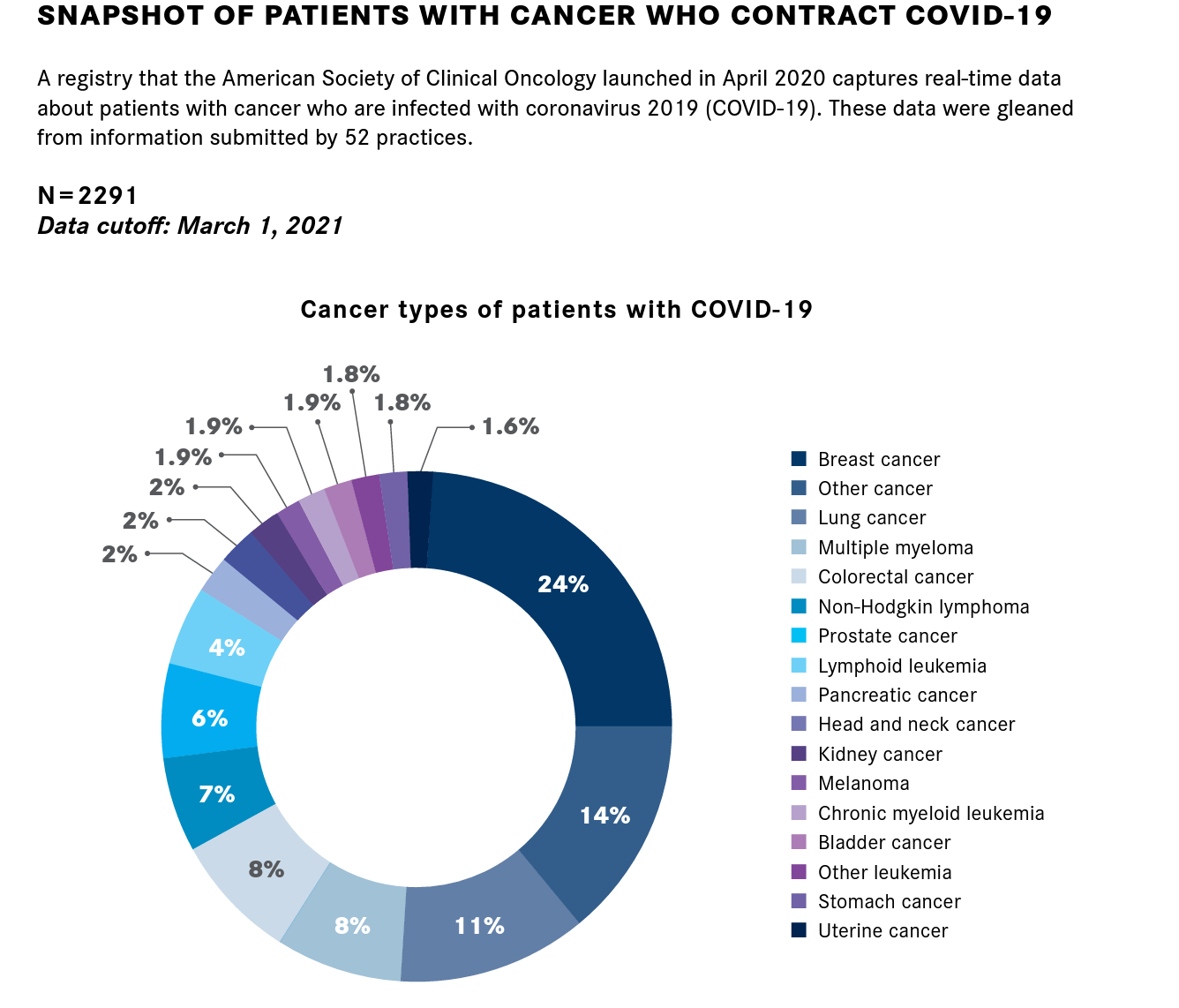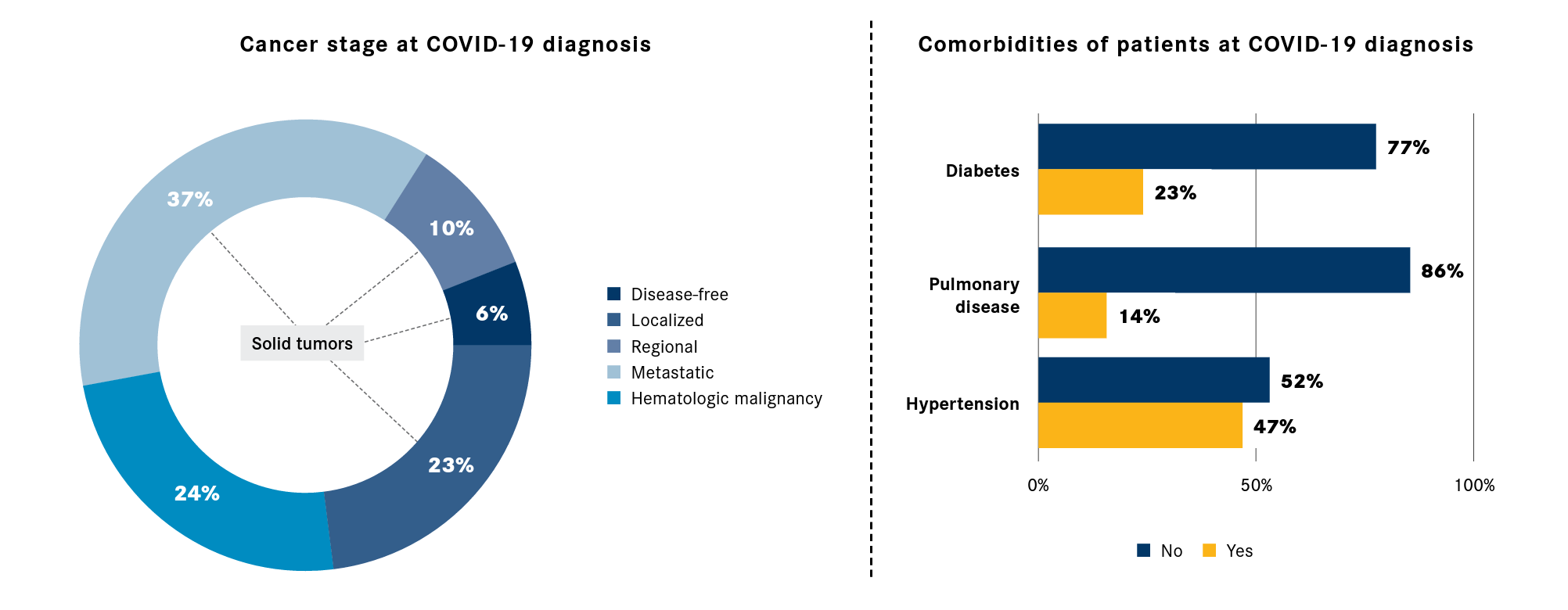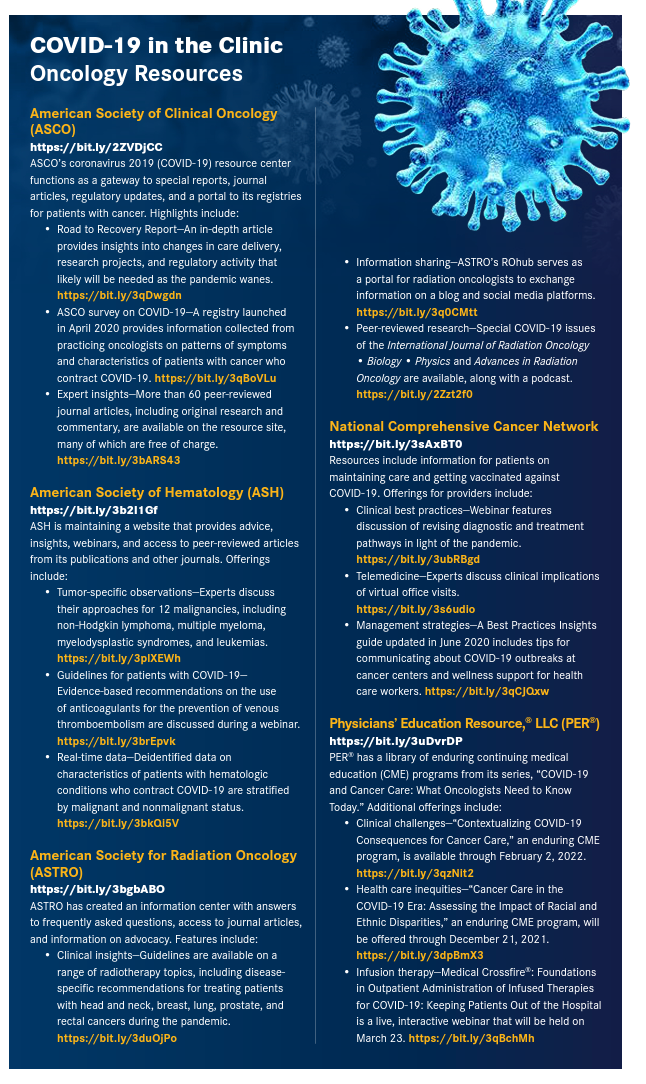- Advertise
- About OncLive
- Editorial Board
- MJH Life Sciences brands
- Contact Us
- Privacy
- Terms & Conditions
- Do Not Sell My Information
2 Clarke Drive
Suite 100
Cranbury, NJ 08512
© 2025 MJH Life Sciences™ and OncLive - Clinical Oncology News, Cancer Expert Insights. All rights reserved.
COVID-19 Spurs New Therapy Trends
When the coronavirus disease 2019 pandemic started upending health care services throughout the United States a year ago, the oncology community moved quickly to develop guidance on selecting therapies and setting treatment schedules for many cancers to allow for less frequent in-patient visits to clinics and infusion centers.

Benjamin D. Smith, MD
When the coronavirus disease 2019 (COVID-19) pandemic started upending health care services throughout the United States a year ago, the oncology community moved quickly to develop guidance on selecting therapies and setting treatment schedules for many cancers to allow for less frequent in-patient visits to clinics and infusion centers.
Now, several therapeutic strategies adopted to cope with the exigencies of the moment are working so well that they could become new standards of care after the pandemic ebbs. These include shorter radiation schedules, broader adoption of oral therapies, and new combinatorial approaches.
Radiation Schedules
Some of these changes would likely have become common eventually in any case, but they were embraced more quickly and widely because of the pandemic, experts say. A prime example is hypofractionation in radiation therapy treatments. In April 2020, as radiation oncologists were still adjusting to COVID-19 protocols, the results of the FAST-Forward trial were published, showing that a 5-fraction schedule of adjuvant radiotherapy delivered in 1 week is noninferior in terms of local cancer control and is as safe as a standard 15-fraction regimen after primary surgery for patients with early-stage breast cancer.1
“We are practicing in the midst of a global pandemic and all of our leadership are telling us, ‘Delay treatment and give the minimum number of treatments you need to help your patients.’ And, like a miracle, suddenly this wonderful 4000-patient randomized clinical trial is published and it illustrates that we can take our 3- to 4-week treatment regimen and compress it to 1 to 2 weeks,” said Benjamin D. Smith, MD, director of research for breast radiation oncology at The University of Texas MD Anderson Cancer Center in Houston, and chair of Clinical Affairs and Quality Council for the American Society for Radiation Oncology (ASTRO).
The phase 3, randomized FAST-Forward trial enrolled 4096 patients who had invasive carcinoma of the breast (pT1-3, pN0-1, M0) after breast conservation surgery or mastectomy. They were assigned to 40 Gy in 15 fractions over 3 weeks, 27 Gy in 5 fractions over 1 week, or 26 Gy in 5 fractions over 1 week to the whole breast or chest wall. The primary end point was ipsilateral breast tumor relapse, with noninferiority predefined as 1.6% or less excess for 5-fraction schedules (HR, 1.81).
At a median follow-up of 71.5 months (interquartile ratio, 71.3-71.7), relapse occurred in 79 patients: 31 in the 40-Gy group, 27 in the 27-Gy group, and 21 in the 26- Gy group. Hazard ratios for therapy compared with 40 Gy in 15 fractions were 0.86 (95% CI, 0.51-1.44) for 27 Gy in 5 fractions and 0.67 (95% CI, 0.38-1.16) for 26 Gy in 5 fractions. Five-year incidence of ipsilateral breast tumor relapse after 40 Gy was 2.1% (95% CI, 1.4%-3.1%); estimated absolute differences compared with 40 Gy in 15 fractions were −0.3% (95% CI, −1.0 to 0.9) for 27 Gy in 5 fractions and −0.7% (95% CI, −1.3 to 0.3) for 26 Gy in 5 fractions (P = .00019 vs 40 Gy in 15 fractions).
At 5 years, moderate or marked clinician- assessed adverse effects (AEs) in normal tissue in the breast or chest wall were reported for 98 of 986 (9.9%) patients who received 40 Gy, 155 (15.4%) of 1005 of those who had 27 Gy, and 121 of 1020 (11.9%) who received 26 Gy. Across all clinician assessments from 1 to 5 years, odds ratios (ORs) vs 40 Gy in 15 fractions were 1.55 (95% CI, 1.321.83; P < .0001) for 27 Gy in 5 fractions and 1.12 (95% CI, 0.94- 1.34; P = .20) for 26 Gy in 5 fractions. Patient and photographic assessments showed a higher risk of AEs for those who received 27 Gy vs 40 Gy but not for participants who had 26 Gy vs 40 Gy.
Smith said some radiation clinics have held off on using the new schedule, but MD Anderson and a number of other centers quickly adopted it. A British study found that for National Health Service patients, use of a hypofractionated regimen of 26 Gy in 5 fractions for breast radiotherapy soared from 0.2% of all sessions in April 2019 to 60.6% in April 2020.2
Smith said the speed with which the new schedule was adopted in the United States represents a sharp contrast from previous changes in radiation therapy practices. “The change from 6-and-a-half weeks of radiation to 4 weeks of radiation literally took more than a decade. There was much foot-dragging. I think the transition to 1 to 2 weeks of radiation is going to happen a lot more quickly because of the pandemic,” he said.

Snapshot of patients with cancer who contract COVID-19
Smith said the COVID-19 emergency probably also sped up adoption of shorter radiation schedules for treatment of prostate and other cancers. Studies support the benefit of ultra-hypofractionation for prostate cancer, including results published in January 2021 indicating that a shorter course of stereotactic body radiotherapy (SBRT) is safe and effective for patients with high-risk disease.3
An analysis of pooled trial and registry data for 344 patients showed that at a median follow-up of 49.5 months, estimated 4-year biochemical recurrence-free survival (BCRFS) and distant metastasis-free survival rates, respectively, were 81.7% (95% CI, 77.2%-86.5%) and 89.1% (95% CI, 85.3%-93.1%). The cumulative incidence of biochemical recurrence, defined as a rise in prostate-specific antigen greater than 2 ng/mL above the lowest value after SBRT, was significantly lower (P = .017) among the 72% of participants who also received androgen deprivation therapy (ADT) at a median duration of 9 months.3
Investigators said these findings were similar to 5-year BCRFS rates among patients who received a brachytherapy boost or dose-escalated conventionally fractionated radiotherapy alone along with 12 months of ADT in the ASCENDE-RT trial (NCT00175396). The cumulative incidences of late grade 2 genitourinary and gastrointestinal toxicity also were considerably lower with SBRT than with standard protocols.3
The hypofractionation trend is affecting clinical trials as well. Smith said he had initially declined to test a 1-week schedule in the OPAL breast cancer irradiation trial (NCT03077841) he is leading at 16 sites, believing that clinicians at other institutions would think it was too extreme. But after the FAST-Forward results were published, he changed the trial to include a 1-week cohort, he said.

Cancer stage at COVID-19 diagnosis and comorbidities of patients at COVID-19 diagnosis
Therapy at Home
Other changes that have allowed patients to reduce medical facility visits include nurse visits to their homes to administer infusions or injections, longer intervals between infusions, and conversion to oral drugs or take-home formulations when possible, experts said in interviews. Many patients with rectal cancers, for example, started taking oral capecitabine (Xeloda) instead of infusional 5-fluorouracil (5-FU), in accordance with guidelines developed by medical organizations.
“During the pandemic it was an easy way to really push some of those oral regimens. I’m confident the usage [of capecitabine] went up pretty dramatically,” said Howard A. “Skip” Burris III, MD, chief medical officer and president of clinical operations at Sarah Cannon in Nashville, Tennessee, and a 2014 Giants of Cancer Care® award winner in the Drug Development category. He also served as president of the American Society of Clinical Oncology (ASCO) for the 2019-2020 term.
Burris said he expects the preference for oral drugs, where appropriate, will continue after the pandemic ends, as there is strong interest in new oral therapies generally. These include CDK4/6 inhibitors that are being studied for use in the neoadjuvant and adjuvant setting for patients with hormone receptor–positive, HER2-negative breast cancer. The first oral taxane could be approved soon and oral checkpoint inhibitors are in active development, Burris noted.
Chancellor Donald, MD, assistant professor of clinical medicine at Tulane University in New Orleans and chair of the American Society of Hematology (ASH) committee on practice, said many oncologists began prescribing oral capecitabine to patients with colon cancer rather than at-home 5-FU infusions; this precluded hospital visits to pick up and drop off ambulatory infusion pumps. However, given the compliance issues concerning oral drugs, Donald said he’s not sure what physicians will do once exposure to COVID-19 at clinics is less of a concern.
“Once you take out the pandemic, once you take out that driver on the other side of the scale when you talk about risk-benefit, it’s hard to predict which way it’ll go. If this pandemic isn’t protracted over years, I think people may start to maybe shift back toward their previous practice habits,” Donald said. Providers may be influenced by their individual experiences of whether telehealth approaches either improve or worsen outcomes in their patients who are given oral rather than intravenous drugs, he added.
At the University of Pennsylvania’s Abramson Cancer Center in Philadelphia, physicians switched out many patients with rectal cancers to capecitabine. They also converted most patients with estrogen receptor–positive breast cancers, who would usually receive traditional intravenous chemotherapy, to oral hormone therapies instead, as is commonly done in Europe, said Lawrence N. Shulman, MD, the center’s deputy director for clinical services and director of the Center for Global Cancer Medicine.
Shulman said Penn investigators had already been studying how to improve patient adherence when they are prescribed oral drugs to take at home. One small study (N = 10) used automated chatbot software to manage patients with gastrointestinal neuroendocrine cancer who were prescribed capecitabine and temozolomide (Temodar).4
“The chatbot checks in with the patient every day, tells them when to take their medicines, asks them how they’re doing, and so on,” Shulman said. The cancer center recently received a grant to continue that work. “COVID has accelerated research in this area because it’s clearly even more important than it was before,” he said.
In the chatbot study, participant satisfaction was high, as was the reliability of the system’s algorithmic branching to provide accurate dosing information and symptom triage. Symptoms were accurately graded 100% of the time and there was appropriate self-management advice or provider triage 100% of the time. Average daily adherence (based on self-reporting) was 97.4%. Participants reported that 3 emergency department visits were avoided during the study period.4
New Combinations
Another shift in treatment of rectal cancers at Penn and many other centers has been toward total neoadjuvant therapy (TNT), in which patients undergo chemotherapy with chemoradiotherapy (CRT) before surgery, instead of having standard concurrent CRT followed by surgery and adjuvant chemotherapy (CRT plus A). TNT had been studied for years but was more fully embraced as a way to allow postponement of surgeries during the early days of the pandemic, Shulman said.
“It turned out to be a good thing to do. We were obviously not the only ones in the country doing it; most people started doing it. But it accelerated the transition to that and made people understand it better and feel more comfortable with it. I think that’ll be something that sticks,” Shulman said.
A meta-analysis of data from 7 studies published in JAMA Network Open in December 2020 supports the use of TNT for patients with locally advanced rectal cancer. The pooled prevalence of pathological complete response (PCR) was 29.9% (range, 17.2%-38.5%) in the TNT group compared with 14.9% (range, 4.2%-21.3%) in the CRT-plus-A group. TNT was associated with a higher chance of achieving a PCR (OR, 2.44; 95% CI, 1.99-2.98). No statistically significant difference in the proportion of sphincter-preserving surgery (OR, 1.06; 95% CI, 0.73-1.54) or ileostomy (OR, 1.05; 95% CI, 0.76-1.46) between recipients of TNT and CRT plus A was observed. In 3 studies that presented data on disease-free survival (DFS), patients who received TNT had significantly higher odds of achieving improved DFS (OR, 2.07; 95% CI, 1.20-3.56).5

COVID-19 in the clinic
Use of Growth Factors
One commonly adopted change used to minimize the likelihood of hospitalization and reduce patients’ vulnerability to infections was expanded use of granulocyte colony-stimulating factors (G-CSF) after therapy to prevent febrile neutropenia. “In the setting of a pandemic, to have someone neutropenic is something that comes with great risk,” Donald said.
A National Comprehensive Cancer Network panel on hematopoietic growth factors recommended changing the threshold for prophylactic use of G-CSF from only patients deemed high risk (> 20% risk of febrile neutropenia) to those considered intermediate (10%-20% risk of febrile neutropenia) or high risk.6
Additionally, the panel members suggested that G-CSF be considered in patients without risk factors for complication to accelerate recovery of absolute neutrophil count after hematopoietic cell transplant to minimize the need for hospitalization. They also said that frequent patient visits to clinics could be avoided with 1 of 3 schedules of self-administered medication: daily filgrastim; long-acting pegfilgrastim 1 to 3 days post chemotherapy; or on-body injector pegfilgrastim (Neulasta Onpro) use 1 day after chemotherapy.6
Shulman’s institution liberalized its G-CSF guidelines. However, “I’m not sure that’s going to stick. I’m not sure it really needs to,” he said. Burris, on the other hand, thinks that expanded use of the growth factors “likely will stick around” because the treatment comes with minimal AEs and patients can administer it themselves.
Long-Term Adoption
The retention or abandonment of some of the changes made during the pandemic will depend on a number of factors, experts said, including any new evidence that emerges in the coming months and years. Burris noted that ASCO launched an oncology registry to capture patterns of COVID-19 symptoms among patients with cancer and to understand how the pandemic is affecting the delivery of cancer care and patient outcomes. CancerLinQ, ASCO’s big data initiative, should also provide some of that information, he said.
Burris and others also said that it is unclear how payer responses to abrupt, major shifts in therapeutic practice will affect their ongoing use of those changes. If payers want to support changes that require fewer in-person appointments, such as greater use of oral drugs instead of infusions or longer intervals between doses, they should consider alternatives to episodic payment systems, Burris said. The recent changes also support reimbursement for the value of care provided rather than for the drugs dispensed, he said.
Payers have encouraged use of take-home therapies and remote treatment by temporarily covering telemedicine at in-person appointment rates or by waiving patient costshare.7 Shulman said that his institution has been discussing with payers how to continue these services after the pandemic, but that it remains to be seen how coverage will be handled in the long term.
In addition, the field of radiation oncology faces a major reckoning as clinics switch to 1- or 2-week treatment schedules instead of those lasting 4 or more weeks, Smith said. Revenues are already dropping and fewer medical students are entering radiation oncology, which could affect the availability of radiotherapy services, he pointed out.
References
- Brunt AM, Haviland JS, Wheatley DA, et al; FAST-Forward Trial Management Group. Hypofractionated breast radiotherapy for 1 week versus 3 weeks (FAST-Forward): 5-year efficacy and late normal tissue effects results from a multicentre, non-inferiority, randomised, phase 3 trial. Lancet. 2020;395(10237):1613-1626. doi:10.1016/S0140-6736(20)30932-6
- Spencer K, Jones CM, Girdler R, et al. The impact of the COVID-19 pandemic on radiotherapy services in England, UK: a population-based study. Lancet Oncol. Published online January 22, 2021. doi:10.1016/S1470-2045(20)30743-9
- van Dams R, Jiang NY, Fuller, DB, et al. Stereotactic body radiotherapy for high-risk localized CARcinoma of the prostate (SHARP) consortium: analysis of 344 prospectively treated patients. Int J Radiat Oncol Biol Phys. Published online January 22, 2021. Accessed February 12, 201. doi:10.1016/j.ijrobp.2021.01.016.
- Berges BM, Cambareri C, Takvorian SU, et al. Leveraging a conversational agent to support adherence to oral anticancer agents: a usability study. J Clin Oncol. 2019;37(suppl 15):6534. doi:10.1200/JCO.2019.37.15_suppl.6534
- Kasi A, Abbasi S, Handa S, et al. Total neoadjuvant therapy vs standard therapy in locally advanced rectal cancer: a systematic review and meta-analysis. JAMA Netw Open. 2020;3(12):e2030097. doi:10.1001/jamanetworkopen.2020.30097
- NCCN hematopoietic growth factors: short-term recommendations specific to issues with COVID-19 (SARS-CoV-2). National Comprehensive Cancer Network; 2020. Accessed February 12, 2021. https://bit.ly/2ZyECae
- Private payers: telemedicine and telehealth updates and information. American Society of Clinical Oncology. Updated February 10, 2021. Accessed February 12, 2021. Accessed February 12, 2021. https://bit.ly/3qA3cnh
Related Content:


 Download Issue : Vol. 22/No. 5
Download Issue : Vol. 22/No. 5

